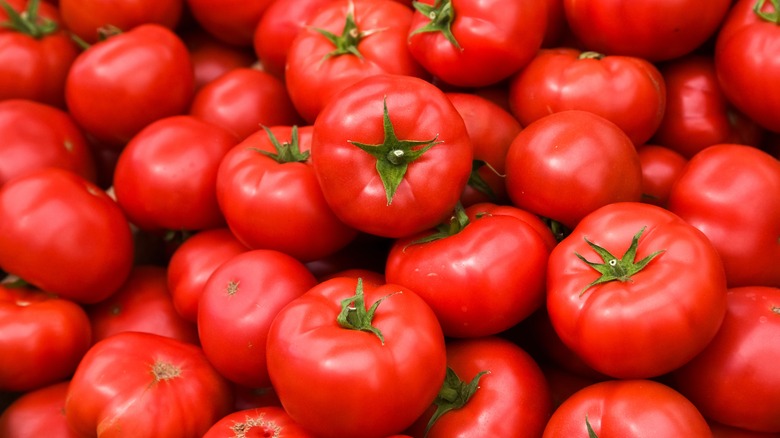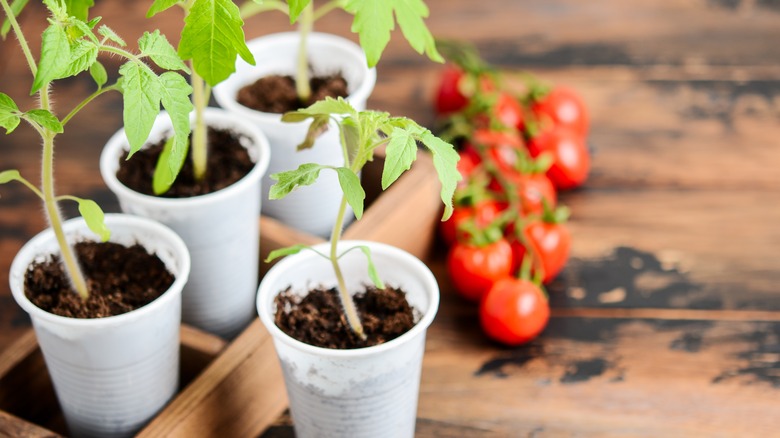Can You Grow Tomatoes Indoors?
You say tomato; I say tomahto... You say outdoors; I say indoors...
Yes, the perennially popular "love apple" can not only be grown inside; it can do well indoors. Two Peas In A Condo claims that a properly cared-for tomato plant grown at home can produce up to 200 fruits in a single season, so choosing the right type and simulating the cultivar's favored outside conditions will allow you to enjoy homegrown tomatoes all year round. Per Happy Sprout, think of an indoor plant as an al fresco one, just living in a container. And while an in-home tomato plant may not be as large or productive as its outdoor cousin, it can provide its bounty from January to December.
South American in origin, there are now approximately 10,000 cultivated varieties, according to The Urban Leaf. The plants fall into two categories: indeterminate (vine type) and determinate (bush style). The latter achieves a limited size but produces a lot of tomatoes — however, only the result of a single good crop. On the other hand, an indeterminate one continues to grow and remains prolific as long as conditions allow. Most dwarf varieties are indeterminate, longer lived than the bush plants, and are described as an ideal indoor option by expert Craig LeHoullier (as quoted in Birds & Blooms). A micro dwarf plant will not exceed 1 foot but will churn out tomatoes throughout the year.
Give them ample light and water
Tomato plants are greedy for light, and one grown indoors is no exception. According to Tomato Bible, at least 10 hours of direct sunlight is a necessity, supplemented with grow lights if necessary during the evening or winter months. A plant might be better exposed to artificial light if kept on a table or shelf. Do not illuminate a tomato plant for 24 hours a day, as it requires six to eight hours of dark rest daily.
If possible, situate the container on a windowsill near a large southern window. The plant will naturally bend toward the light, so be sure to rotate it routinely. At summer's end, if you are moving a cultivar inside, Gardening Channel recommends minimizing stress to the plant by digging it up in the evening hours and allowing it to gradually acclimate to the darker indoor conditions it will be experiencing. Then, move it to a shady area for a few days before bringing it inside.
As tomatoes crave light, so do they thrive on water. Therefore, it is preferable to overwater a mature plant than the opposite. Espoma suggests watering a container plant in the morning until the liquid reaches the bottom of the pot. Examine the cultivar in the afternoon and re-water if dry. To determine dryness, poke your finger in the soil, and if it is not wet 1 inch below the surface, it needs water.
Temperature and other growing conditions
The goal is to match ideal outdoor light, temperature, and humidity conditions as closely as possible. Tomato Dirt recommends maintaining an indoor range of 65 to 85 degrees Fahrenheit, avoiding drafts, and moving the plant away from the window at night. You can use a space heater or heat mat to raise the temperature, or the tomato plant can be housed in a glass enclosure. Make sure not to go below 59 degrees Fahrenheit to avoid stunting the cultivar or damaging its fruit.
If growing your own plant, seeds will germinate in five to 10 days. When eventually transplanted, a 5-gallon container at least 10 to 12 inches deep will suffice to contain the plant and its roots. Just Home Gardening suggests using loose, sterile soil that drains well. The growing medium should be high in potassium and phosphorous and nearly pH neutral.
Furthermore, an indoor tomato plant is capable of self-pollinating, but a little help will produce dividends. For best results, tap or gently shake the plant daily or swab around it after it has flowered. According to Jobe's, if all goes well, an inside tomato cultivar will generate fruit in two to three months at a rate similar to an outdoor one. Per Healthline, with a bit of care and attention, your indoor friend will reward you with a delicious and healthy treasure trove of Vitamin C, potassium, lycopene, Vitamin K, and folate.


